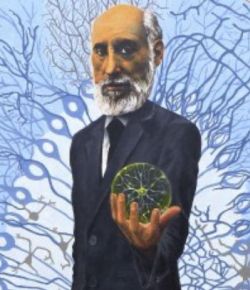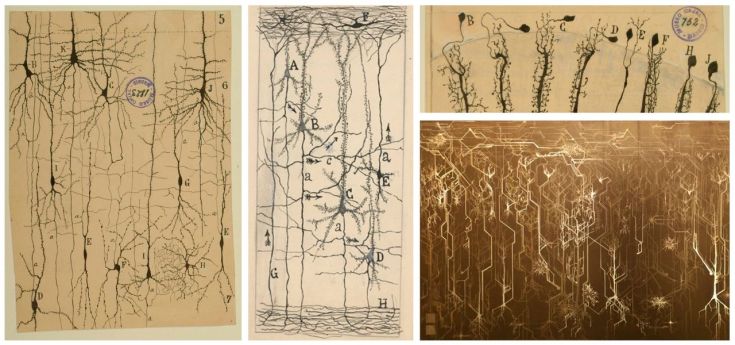 In 1986, the co-founder of the Massachusetts Institute of Technology’s AI laboratory’s, cognitive scientist Marvin Minsky, (1927-2016), published The Society of Mind. The book describes a theory which attempts to explain how what we call intelligence, could be a product of the interaction of non-intelligent parts. He proposed that each mind is made of many small processes which can only do thoughtless, simple things. Intelligence, he said, is the result of joining these parts with multi cross-connections in societies of tangled webs. Minsky concluded that much of the brain’s power stems from merely the messy ways these processes are interconnected.
In 1986, the co-founder of the Massachusetts Institute of Technology’s AI laboratory’s, cognitive scientist Marvin Minsky, (1927-2016), published The Society of Mind. The book describes a theory which attempts to explain how what we call intelligence, could be a product of the interaction of non-intelligent parts. He proposed that each mind is made of many small processes which can only do thoughtless, simple things. Intelligence, he said, is the result of joining these parts with multi cross-connections in societies of tangled webs. Minsky concluded that much of the brain’s power stems from merely the messy ways these processes are interconnected.
The book’s primary accomplishment was to put information into terms written for the general public, to explain the functions of the synapses (junctions between two nerve cells, consisting of a minute gap across which impulses pass by diffusion of a neurotransmitters); and neurotransmitters (chemical messengers which transmit signals across a chemical synapses). These basic units of the organization of the nervous system, were represented by individual cellular elements, which Wilhelm Gottfried von Waldeyer-Hartz, (1836-1921), christened as “neurons” in 1891. It was, however, through the work conducted by Spanish neuroscientist, Santiago Ramón y Cajal, (1852-1934), by which the unsurpassed discovery of the independent functionality of neurons within the nervous system was made possible.
Cajal observed and described these points of contact in which various chemical substances intervene in detail, and, he did it at a time when there were no instruments that allowed the physiological verification of his brilliant deduction. He was fiercely opposed to the idea that the nervous system was made up of a network of continuous elements, as it had been stated by Joseph von Gerlach, (1820-1896), and supported by Camillo Golgi, (1843-1926). For Cajal, it was very clear that nerve cells worked independently in a nervous system in which the current had to follow a certain direction; from the dendrites to the neuron body and from this to the axon, which in turn transmits the impulse to other dendrites of other cells.
Cajal’s opus ,“Textura del Sistema Nervioso del Hombre y los Vertebrados” (1894-1904), was made available to the international scientific community in a French translation, “Histologie du Système Nerveux de l’Homme et des Vertébrés”, translated by Dr. L. Azoulay, and published in 1911, in 2 volumes by Maloine, Paris. The English translation, by N. and L.W. Swanson, was published in 1994, by Oxford University Press. The book provided the foundation of modern neuroanatomy, with a detailed description of nerve cell organization in the central and peripheral nervous system of numerous animal species, illustrated by Cajal’s renowned drawings. These drawings are still reproduced in neuroscience textbooks today.
The techniques used to create artificial intelligence are inspired by neurons in the human brain, and are known as neural networks. Neural networks power deep learning systems. They are composed of layers of interconnected artificial “neurons” that automatically learn about the features of a specific object based on large amounts of training data. For example, by looking at images of dogs, a neural network can learn about a dog’s features by tweaking the connections between neurons. If it has learned those patterns well, it should be able to look at an image and correctly identify it as a dog. However, a slight alteration of a few pixels in the adversarial samples, which are created when an AI system is classifying data, may cause a misclassification of the depiction of dogs in the AI system.
Adversarial networks, a technique which incorporates two neural networks with two different goals: one to make accurate classifications, the other altering the samples to trigger misclassifications, is the latest development in machine learning. They provide a way to conduct unsupervised learning, in which a machine could make logical inferences without requiring as much human training data and with a reduction in errors. Last October, Christie’s sold an AI-generated portrait of Edmond De Belamy, for US $432,500, over 43 times its highest pre-sale estimate. The portrait was created from 15,000 portrait images .This portrait was drawn by an algorithm, which was created by Ian J. Goodfellow. He is currently a research scientist in machine learning at Google Brain and the inventor of the AI algorithm named GAN (Generative Adversarial Networks). The 27 ½ x 27 ½ in (700 x 700 mm.), portrait is signed at the bottom right by part of the algorithm code that produced it:
{\displaystyle \min _{\mathcal {G}}\max _{\mathcal {D}}E_{x}\left[\log({\mathcal {D}}(x))\right]+E_{z}\left[\log(1-{\mathcal {D}}({\mathcal {G}}(z)))\right]} {\displaystyle \min _{\mathcal {G}}\max _{\mathcal {D}}E_{x}\left[\log({\mathcal {D}}(x))\right]+E_{z}\left[\log(1-{\mathcal {D}}({\mathcal {G}}(z)))\right]}
This MIT Technology Review report quote:- “AI’s chief legacy might not be driverless cars or image search or even Alexa’s ability to take orders, but its ability to come up with new ideas to fuel innovation itself,” is already taking shape.


{ 0 comments… add one now }